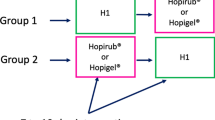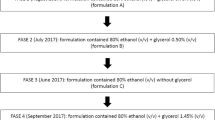Abstract
Background and aims
Ethanol- or 1-propanol-containing hand disinfectants are widely used as surgical hand antisepsis. The primary objective of this study was to investigate transdermal absorption of ethanol and 1-propanol from combination of 45% ethanol and 18% 1-propanol with skin protecting ingredients (Softa-Man®) within 1 h after application in comparison to the absorption of these alcohols from the product in the absence of the cosmetic additives. The secondary objective was to evaluate the dermal tolerability.
Materials and methods
Following the double-blind, randomized cross-over design for this clinical trial, 20 ml of two different alcohol-containing disinfectants was applied with a 200-cm2 gauze swab on a skin area, identical in size and location, of 14 healthy volunteers for 10 min to investigate the absorption rate of ethanol and 1-propanol. Local dermal tolerability was evaluated using a four-point erythema scale.
Results
No clinically relevant dermal absorption, with respect to ethanol and 1-propanol, could be observed within 1 h after application. Disinfectant-related mild local skin erythema was observed in three cases.
Conclusion
The use of the tested formulations containing ethanol and 1-propanol can be considered as safe. The tested formulation containing skin protecting additives (Softa-Man®) does not result in more alcoholic absorption than the formulation without protective additives.

Similar content being viewed by others
References
Yosef A, Dolan MJ, Fendler EJ, Larson EL (2001) Alcohols. In: Block SS (ed) Disinfection, sterilization and preservation, 5th edn. Williams & Wilkins, Philadelphia, pp 229–253
International Guidelines of AWMF-Registration No. 076/001 (2003) Acute treatment of alcohol use disorders. Sucht 49(3):147–167
Boyce JM, Pittet DP (2002) Guideline for hand hygiene in health-care settings. MMWR Recomm Rep 51:1–44
Scheuplein RJ, Blank IH (1973) Mechanisms in percutaneous absorption. IV. Penetration of non-electrolytes (alcohols) from aqueous solutions and from pure liquids. J Invest Dermatol 60(5):286–296
Turner P, Saeed B, Kelsey MC (2004) Dermal absorption of isopropyl alcohol from a commercial hand rub: implications for its use in hand decontamination. J Hosp Infect 56:287–290
Vivier PM, Lewander WJ, Martin HF, Linakis JG (1994) Isopropyl alcohol intoxication in a neonate through chronic dermal exposure: a complication of culturally-biased umbilical care practice. Pediatr Emerg Care 10(2):91–93
Rajabally YA, Mortimer NJ (2004) Acute neuropathy and erythromelagia following topical exposure to isopropanol. Vet Hum Toxicol 46(1):24–25
Dyer S, Myck MB, Ahrens WR, Zell-Kanter M (2002) Hemorrhagic gastritis from topical isopropanol exposure. Ann Pharmacother 36(11):1733–1735
Leeper SC, Almatari AL, Ingram JD, Ferslew KE (2000) Topical absorption of isopropyl alcohol induced cardiac and neurologic deficits in an adult female with intact skin. Vet Hum Toxicol 42(1):15–17
Peschel O, Bauer MF, Gilig T, Meyer LV, von Meyer L (1992) Change in congener analysis caused by percutaneous absorption of propanol-containing antiseptics. Blutalkohol 29(3):172–184
Martinez TT, Jaeger RW, deCastro FJ, Thompson MW, Hamilton MF (1986) A comparison of the absorption and metabolism of isopropyl alcohol by oral, dermal and inhalation routes. Vet Hum Toxicol 28(3):233–236
Kirschner MH, Lang RA, Breuer B, Breuer M, Gronover CS, Zwingers T, Böttrich JG, Arndt A, Brauer U, Hintzpeter M, Burmeister MA, Fauteck JD (2009) Transdermal resorption of an ethanol- and 2-propanol-containing skin disinfectant. Langenbecks Arch Surg 394(1):151–157
Eisenbeiss C, Welzel J, Schmeller W (1998) The influence of female sex hormones on skin thickness: evaluation using 20 MHz sonography. Br J Dermatol 139(3):462–467
Borneff M, Hingst V, Sonntag HG (2003) Recommendations of the University of Heidelberg. Hygiene recommendations, Heidelberg
Disinfections Committee of the German Society for Hygiene and Microbiology (DGHM) (2000) List of disinfection procedures according to the Guidelines for Testing Chemical Disinfectants and found effective by the DGHM, Bonn. Guidelines for testing chemical disinfectants. mhp-Verlag GmbH, Wiesbaden
Sauter R, Steinijans VW, Diletti E, Boehm A, Schulz HU (1992) Presentation of results from bioequivalence studies. Int J Clin Pharmacol Ther Toxicol 30(1):S7–S30
Pendlington RU, Whittle E, Robinson JA, Howes D (2001) Fate of ethanol topically applied to skin. Food Chem Toxicol 39(2):169–174
Kramer A, Below H, Bieber N, Kampf G, Toma CD, Huebner NO, Assadian O (2007) Quantity of ethanol absorption after excessive hand disinfection using three commercially available hand rubs is minimal and below toxic levels for humans. BMC Infect Dis 7:117
Peek GJ, Marsh A, Keating J, Ward RJ, Peters TJ (1990) The effects of swabbing the skin on apparent blood ethanol concentration. Alcohol 25(6):639–640
Fritsch P (2003) Dermatologie Venerologie. Springer, Berlin
Kampf G, Muscatiello M, Häntschel D, Rudolf M (2002) Dermal tolerance and effect on skin hydration of a new ethanol-based hand gel. J Hosp Infect 52(4):297–301
Kampf G, Muscatiello M (2003) Dermal tolerance of Sterilium, a propanol-based hand rub. J Hosp Infect 55(4):295–298
Conflicts of interest
None.
Author information
Authors and Affiliations
Corresponding author
Additional information
Reinhold Andreas Lang and Dianne Egli-Gany have contributed equally to this work.
Rights and permissions
About this article
Cite this article
Lang, R.A., Egli-Gany, D., Brill, F.H.H. et al. Transdermal absorption of ethanol- and 1-propanol-containing hand disinfectants. Langenbecks Arch Surg 396, 1055–1060 (2011). https://doi.org/10.1007/s00423-010-0720-4
Received:
Accepted:
Published:
Issue Date:
DOI: https://doi.org/10.1007/s00423-010-0720-4




